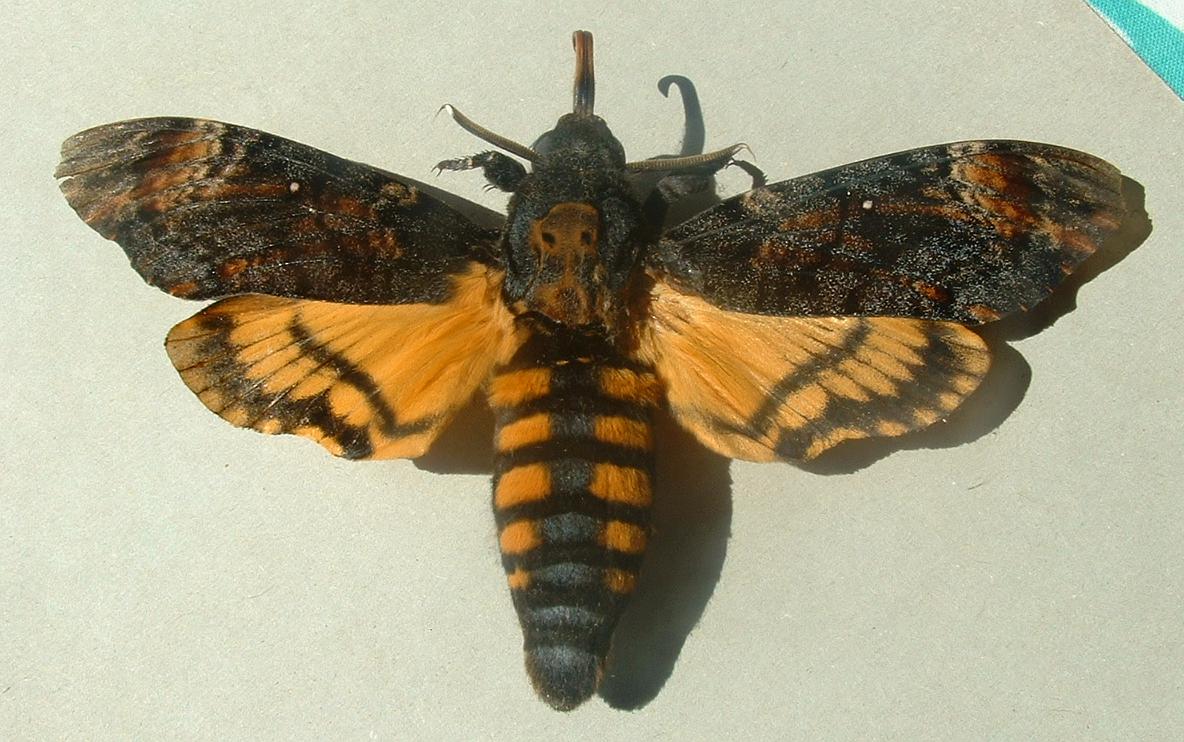- Acherontia atropos
Taxobox
name = "Acherontia atropos"

image_caption = "Acherontia atropos"
regnum =Animal ia
phylum =Arthropod a
classis =Insect a
ordo =Lepidoptera
familia =Sphingidae
subfamilia =Sphinginae
genus = "Acherontia "
species = "A. atropos"
binomial = "Acherontia atropos"
binomial_authority = (Linnaeus , 1758)"Acherontia atropos" is the most widely-known of the three species of
Death's-head Hawkmoth . Found throughout theMiddle East and theMediterranean region, and increasingly as far north as southernGreat Britain due to recently mild British winters, this moth is easily distinguishable from others in this region by a vaguelyskull -shaped pattern on its back. "A. atropos" is also very large, with a wingspan of 90-130 mm (three to five inches), being the largest moth in some of the regions in which it is found. The adult has the typical streamlined wings and body ofSphingidae . The upper wings are brown with slight yellow wavy lines; the lower wings are yellow with some wide brown waves. It rests during the day on trees or in the litter, holding the wings like a tent over the body.The moth also has numerous other unusual features. It has the ability to emit a loud squeak if irritated. The sound is produced by expelling air from its
proboscis . It often accompanies this sound with flashing its brightly marked abdomen in a further attempt to deter its predators. It is commonly observed raiding beehives for honey at night. Unlike the other species of "Acherontia", it only attacks colonies of the well-knownWestern honey bee , "Apis mellifera". It is attacked by guard bees at the entrance, but the thick cuticle and resistance to venom allow it to enter the hive. It is able to move about in hives unmolested because it mimics the scent of the bees. [Moritz, RFA, WH Kirchner and RM Crewe. 1991. Chemical camouflage of the death's head hawkmoth ("Acherontia atropos" L.) in honeybee colonies. Naturwissenschaften 78 (4): 179-182.]The British entomological journal Atropos takes its name from this species.
Distribution
"A. atropos" is Afrotropical and Mediterranean, occurring as far east as Kuwait and western Saudi Arabia, and as far west as the Canary Islands and Azores. Resident in southern Europe, it invades western Eurasia frequently, although few individuals successfully overwinter.Pittaway, AR. 1993. The hawkmoths of the western Palaearctic. Harley Books, London.]
Development
There are several generations a year, with continuous broods in Africa. In the northern parts of its range it overwinters in the pupal stage. Eggs are laid singly under old leaves of
Solanaceae :potato especially; alsoVerbenaceae ,Oleaceae and others. The larvae are stout with a downward-curving 'horn' at the tail end. The larva starts out a light shade of green but darkens after feeding, with yellow stripes diagonally on the sides. In the secondinstar , it has thorn-like horns on the back. In the third instar, purple or blue edging develops on the yellow stripes and the tail horn turns from black to yellow. In the final instar, the thorns disappear and the larva may adopt one of three color morphs: green, brown, or yellow. Larvae do not move much, and will click their mandibles or even bite if threatened. It grows to 120-130 mm, and pupates in an underground chamber. The pupa is smooth and glossy with the proboscis fused to the body.Folklore
The skull pattern has helped the moth earn a negative reputation, such as associations with the supernatural and evil. Numerous
superstition s claim that the moth brings bad luck to the house into which it flies: death or gravemisfortune . [http://www.centralpets.com/animals/insects/other_insects/bug4652.html]It has been featured in art (notably in "
The Hireling Shepherd "), Bram Stoker's "Dracula " and in movies, notably in "Un chien andalou " and "The Silence of the Lambs". In the latter the moth is used as a calling card by the serial killer "Buffalo Bill". In "The Mothman Prophecies" this moth is referenced to on more than a few occasions. It also appears in the music video toMassive Attack 's single, "Butterfly Caught."The moth is also mentioned as symbol of death in John Keats's "Ode to Melancholy", "Make not your rosary of yew-berries, / Nor let the beetle, nor the death-moth be / Your mournful Psyche". [http://www.bartleby.com/101/628.html Full Text]
References
External links
* [http://tpittaway.tripod.com/sphinx/a_atr.htm A. atropos detailed information]
Wikimedia Foundation. 2010.
